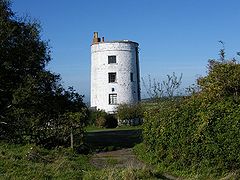Walton, Somerset
| Walton | |
|---|---|
 Walton windmill |
|
| Walton shown within Somerset | |
| Population | 1,106 (2011) |
| OS grid reference | ST465365 |
| District | |
| Shire county | |
| Region | |
| Country | England |
| Sovereign state | United Kingdom |
| Post town | STREET |
| Postcode district | BA16 9 |
| Dialling code | 01458 |
| Police | Avon and Somerset |
| Fire | Devon and Somerset |
| Ambulance | South Western |
| EU Parliament | South West England |
| UK Parliament | |
Walton is a village and civil parish, on the Polden Hills, 1.5 miles (2.4 km) west of Street in the Mendip district of Somerset, England. The parish includes the hamlet of Asney.
Saxon pressure seems to have driven the Britons from the immediate area around 650 A.D. About 700 A.D. the former Celtic monastery at Glastonbury was revived under royal Saxon patronage. By about 740 A.D. the general lines of parish boundaries in this area seem to have been fixed. This early development may well have been due to the organising urges of the monastic authorities. The parish of Walton was part of the Whitley Hundred, which took its name from Whitley Wood in the parish.
The name Walton comes from settlement/farmstead of Wealas — native Celts which is what the new Anglo Saxon speaking peoples called the native inhabitants of England. There is strong evidence that in many areas of England taken over by Germanic speaking settlers, the native British (Wealas) remained undisturbed, farming the same land they did when the Romans left. Over time they just adopted or forgot their Celtic tongue (similar to Old Welsh/Cornish) for the language and culture of the newcomers in order to climb the social ladder or were coerced to do so. It was in the Anglo Saxon interest that the native British carry on as usual to ensure the economy produced food and goods for the new landowners.
Walton was a manor of Glastonbury Abbey at the time of the Domesday Book, which talks about 30 hides. A hide for tax purposes (Danegeld) was counted as about 150 acres (0.61 km2) worked under the 3 field system. Thus Walton could have been some 4,500 acres (18 km2), all owned and directly managed by the Abbey. With the Dissolution of the monasteries and the scramble for monastic assets, Sir John Thynne of Longleat acquired Walton; lock, stock and barrel. The entire village was owned by the Bath estate until sold by auction in 1939.
...
Wikipedia

